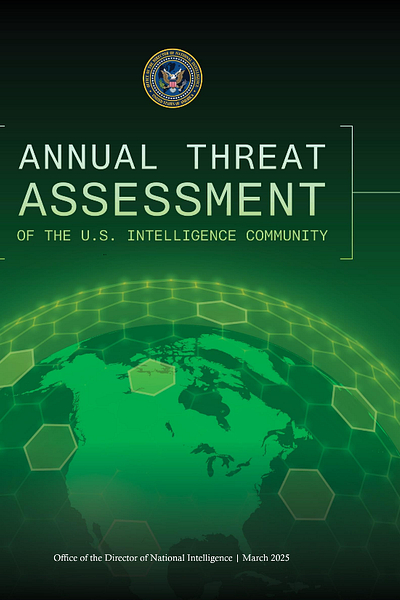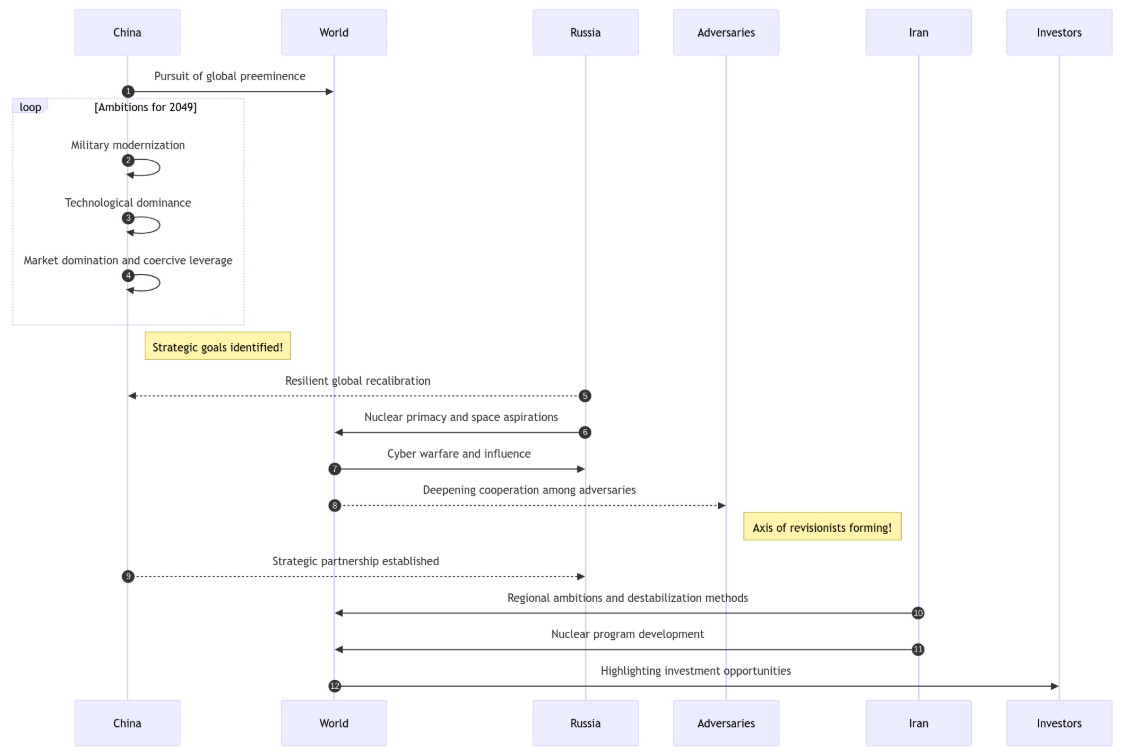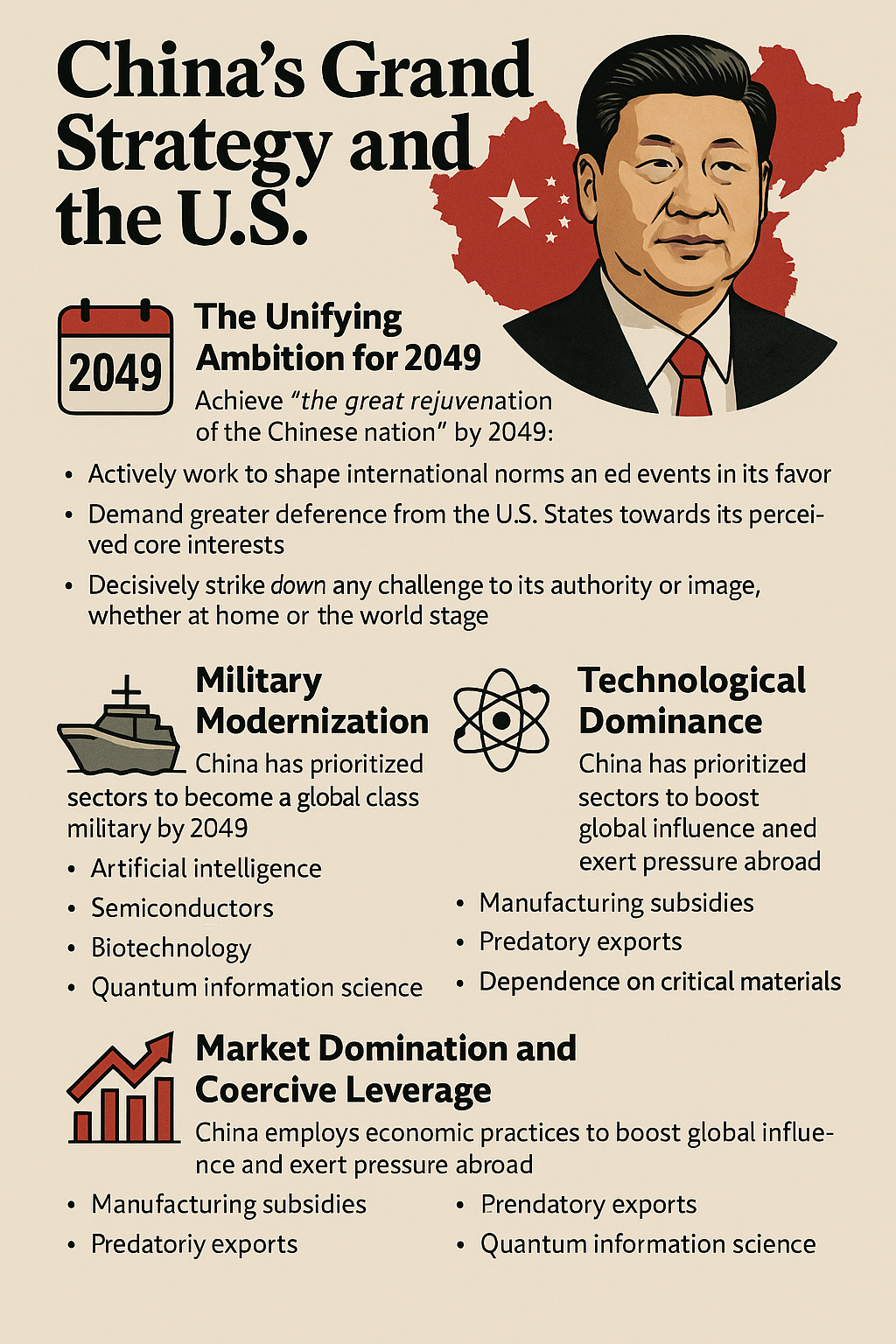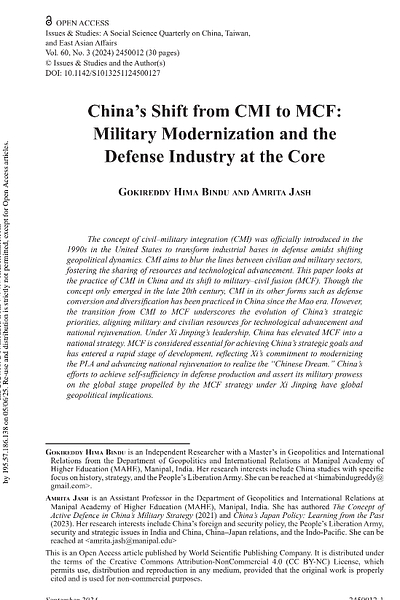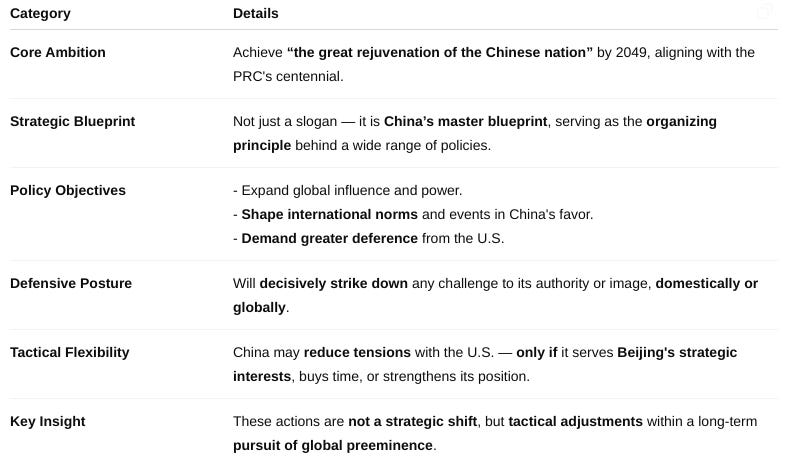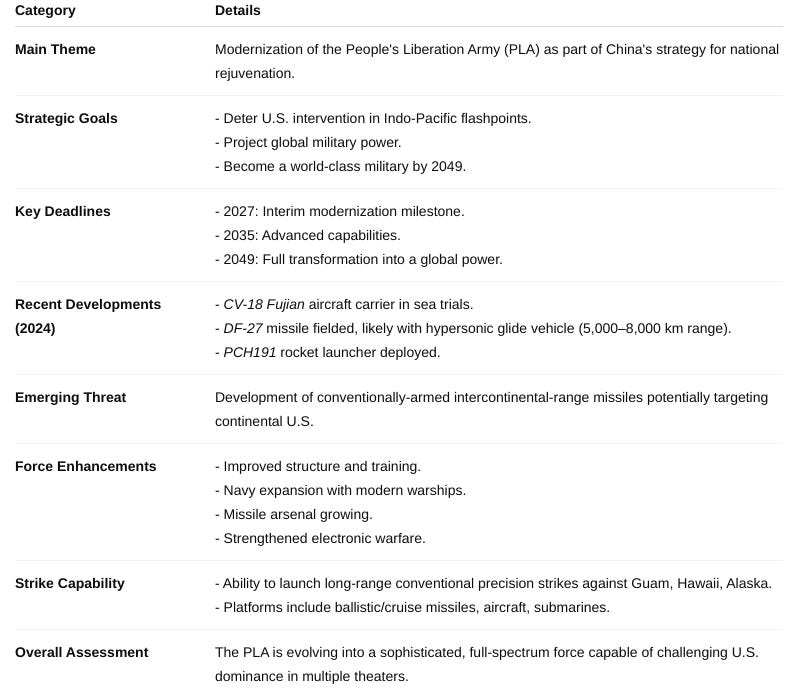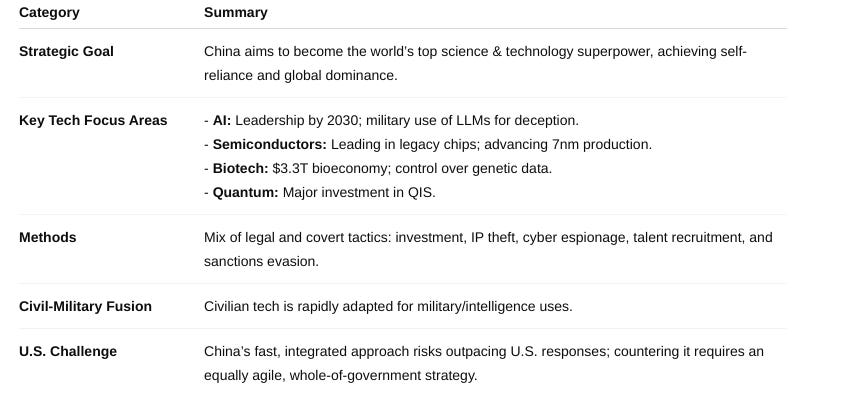[Intel Report] Analysis of the 2025 U.S. intelligence community
A global snapshot of the Macro situation
Table of contents:
Introduction.
China's relentless pursuit of global preeminence.
The unifying ambition for 2049.
Military modernization.
Technological dominance.
Market Ddomination and coercive leverage.
Russia, a resilient and disruptive global power recalibrating its assault.
Nuclear primacy, space aspirations, and conventional adaptation.
Cyber warfare and malign influence.
Deepening cooperation among U.S. adversaries.
The nature of the axis of revisionists.
China-Russia strategic partnership.
Iran-Russia military and technical symbiosis.
North Korea-Russia munitions for expertise and legitimacy.
North Korea's independent threat vectors.
Iran and its proxies as key destabilizers.
Iran's regional ambitions and methods.
Iran's nuclear program.
Investment opportunities.
Introduction
Alright, let's put on the analytical lens and frame the 2025 Annual Threat Assessment (ATA) report in terms of risk models, strategic positioning, and dynamic system interactions.
You can access the full report for a deeper dive into the data and analysis here:
Here's a recalibrated view of the 2025 ATA:
The 2025 Annual Threat Assessment, a key output released in March 2025 from the Office of the Director of National Intelligence, provides a systematic read on the global security risk landscape. It characterizes an environment increasingly defined by accelerated strategic positioning, the assertive calibration efforts of revisionist state actors, and the persistent, evolving nature of transnational risk vectors.
This assessment, derived from the consolidated data streams of the 18 U.S. intelligence elements, serves to provide policymakers, operational planners, and domestic security personnel with the high-fidelity, de-correlated intelligence necessary for optimizing American life protection and U.S. interest safeguarding across the global footprint. Prepared with information available as of March 18, 2025, the report prioritizes the most impactful, near-term threats expected within the next twelve months, while also flagging nascent signals that could indicate larger future shifts in the threat function.
The ATA highlights that a diverse portfolio of foreign actors—spanning state adversaries, their proxies, and non-state entities—are actively applying pressure across critical vectors targeting U.S. interests, including:
U.S. population health and safety.
Essential infrastructure.
Core industries.
National economic wealth.
Governmental institutions.
These actors are not merely optimizing their individual objective functions but are also collectively demonstrating a correlated negative beta exposure to U.S. strength, actively endeavoring to diminish and displace U.S. economic and military influence both regionally and globally. The current threat landscape demands a sophisticated understanding not only of individual adversary capabilities and intent profiles but also of their dangerous interplay and the potential for compounding systemic risk through cooperative behaviors.
Interestingly, despite the rapidly shifting risk parameters described, a notable observable in the 2025 ATA is its reflection of analytic continuity within this high-volatility environment. The U.S. Intelligence Community's principal analytical model, particularly regarding China as the dominant strategic factor and the high correlation coefficients observed between technology acquisition, economic leverage, and national security outcomes, will resonate with those tracking these assessments over recent cycles. This consistency suggests the underlying drivers exhibit relatively low drift, implying that established U.S. risk-mitigation frameworks and response protocols, such as the granular scrutiny applied by the Committee on Foreign Investment in the United States (CFIUS) to investments linked to primary strategic competitors or involving critical technologies, are likely to persist and potentially scale. For U.S. adversaries, this predictability in American focus areas might, in turn, incentivize them to further refine their strategic optimization algorithms to circumvent known U.S. constraints, potentially leading to a more sophisticated and dynamic contest in domains like technology transfer, cyber operations, and influence campaigns.
Furthermore, the 2025 ATA underscores the normalization of competition below the traditional threshold of armed conflict. Key state adversaries, including China, Russia, Iran, and North Korea, are increasingly challenging U.S. interests through deliberate campaigns designed for asymmetrical gain within defined war-avoidance parameters. They employ a multi-asset portfolio spanning calibrated conventional signaling, asymmetric tactics, and efforts to promote alternative international system architectures, particularly in trade and finance. This strategic environment, where sub-threshold activities constitute the primary operating domain for these states, necessitates a U.S. adaptation that extends beyond traditional military preparedness, requiring a full-spectrum enterprise risk management response across the whole of government. The inherent opacity within this sub-threshold parameter space introduces significant tail risk from miscalculation or boundary condition testing, particularly if U.S. red lines are imprecisely defined or if adversaries misjudge U.S. response functions to non-military provocations.
Let's get to it. We're not going to review all the points, but rather those that interest us from Marco's point of view.
China's relentless pursuit of global preeminence
The 2025 Annual Threat Assessment doesn't mince words. It points an unequivocal finger at the People's Republic of China, under President Xi Jinping's leadership, as the ultimate challenger—the most complete and formidable strategic competitor, and the most significant long-term national security threat confronting the United States.
What fuels Beijing's actions? A deep-seated suspicion. They genuinely believe Washington's policies are a deliberate, concerted effort: aiming to box in China's rise, chip away at the Chinese Communist Party's power and legitimacy, and ultimately block the PRC from achieving its grand strategic ambitions on the world stage. This perception is a critical driver behind their moves.
Go deeper by reviewing this:
The unifying ambition for 2049
At the very heart of China's strategic engine sits one colossal ambition: achieving nothing less than "the great rejuvenation of the Chinese nation" by 2049, marking the PRC's centennial. This isn't just a slogan; it's the master blueprint, the central organizing principle powering a sweeping array of policies.
These policies are designed to aggressively expand China's global muscle and influence through actions including:
Actively working to shape international norms and events in its favor.
Demanding greater deference from the United States towards its perceived core interests.
Decisively striking down any challenge to its authority or image, whether at home or on the world stage.
Now, here's a crucial detail: while China might strategically choose to dial down bilateral tensions with the U.S. sometimes – but only when it directly serves Beijing's advantage, protects a vital interest, or buys them strategic breathing room to consolidate their power – do not mistake these moves for a fundamental shift. These are merely tactical adjustments within a much larger, absolutely unwavering pursuit of global preeminence.
Military modernization
Want to see the engine powering China's "great rejuvenation"? Look no further than the dramatic modernization underway in the People's Liberation Army (PLA). This isn't just an upgrade; Beijing is systematically forging a joint force designed for full-spectrum warfare, capable of operating across all domains.
Their aim is crystal clear: not only to possess the muscle needed to challenge potential U.S. intervention in flashpoints, especially across the vital Indo-Pacific, but also to project Chinese military power on a truly global scale. The PLA has set ambitious deadlines, targeting key modernization milestones by 2027 and 2035, relentlessly pushing towards becoming a world-class military powerhouse by 2049.
And the progress isn't theoretical – we saw concrete leaps in 2024 alone. Significant advancements include:
The PLA Navy's imposing third aircraft carrier, the CV-18 Fujian, hit the water for sea trials and is anticipated to join the fleet for operational duty this year.
The PLA Rocket Force is reportedly fielding the DF-27 ballistic missile, a system potentially armed with a terrifying hypersonic glide vehicle payload and packing an estimated range of 5,000 to 8,000 kilometers.
On the ground, forces are deploying their most advanced long-range precision strike system, the potent PCH191 multiple rocket launcher.
But here's the assessment that raises a significant red flag: China may be exploring the development of conventionally-armed intercontinental-range missile systems. If these are fielded, it represents a profound escalation, granting China the capability to threaten conventional precision strikes against targets within the continental United States. This would undeniably re-write the strategic rulebook.
Across the board, the PLA has sharpened its force structure, ramped up readiness, and refined training. We're seeing major strides in ground forces, the navy rapidly expanding with advanced warships, a parade of new and more capable missile systems coming online, and significant boosts to their electronic warfare capabilities. Right now, they already possess the demonstrated capability to execute long-range conventional precision strikes against the doorstep of the U.S. Homeland in the Western Pacific – think Guam, Hawaii, and Alaska – using a diverse arsenal of ballistic and cruise missiles launched from mainland China, as well as from their air and increasingly capable naval platforms, including nuclear-powered submarines. This is a military transforming at pace.
Technological dominance
China isn't just participating in science and technology; it's executing an aggressive, full-throttle, whole-of-government strategy to seize the crown as a global S&T superpower. Think of it as a national sprint, relentlessly driven by extensive state control and aiming to leapfrog the United States across crucial tech frontiers, achieve complete self-reliance, and unlock massive new economic, political, and military advantages.
Beijing has clearly staked its claim on the front lines of this tech race, heavily prioritizing key sectors:
Artificial intelligence: China is boldly aiming to displace the U.S. as the world's AI heavyweight by 2030. They're experiencing a boom in generative AI, aggressively pushing applications from building smarter cities and enabling widespread surveillance to revolutionizing healthcare and developing advanced intelligent weapons systems. Critically, the PLA is likely gearing up to leverage large language models to unleash sophisticated information deception attacks, capable of churning out fabricated news, mimicking online identities, and orchestrating vast influence networks.
Semiconductors: While facing a significant bottleneck in cutting-edge tools, China has still made tangible strides, managing to produce advanced 7-nanometer chips. They're actively exploring ingenious ways to push the boundaries with older equipment. And notably, they already dominate the production of legacy chips and are on track to add more manufacturing capacity in this foundational area than the rest of the world combined through 2028.
Biotechnology: Seen as the next frontier for economic dominance, Beijing is pouring resources into biotech, targeting a massive $3.3 trillion bioeconomy this year. They have a massive appetite for health and genetic data, hoovering it up both domestically and internationally, and have become highly competitive in areas like biomanufacturing and genetic sequencing. China sees genetic data itself as a strategic national treasure, tightening state control over gene banks and positioning itself to potentially lead the charge in areas like precision medicine and future agricultural tech.
Quantum information science: This cutting-edge field is also squarely in Beijing's sights, further underscoring their ambition across the technological spectrum.
To turbocharge this ascent, China employs a suite of tactics, spanning both legitimate investment and a shadowy side that includes intellectual property acquisition and outright theft, sophisticated cyber espionage, aggressive global talent recruitment, international collaborations, and concerted efforts to evade international sanctions. It's an alarming reality that a significant chunk of U.S. economic espionage cases investigated point back to PRC state-sponsored or affiliated entities – highlighting the industrial scale of this challenge.
Here's why this isn't just about tech patents: China's strategy is comprehensive. These technological advancements aren't isolated; they seamlessly flow into fueling military modernization, sharpening economic competitiveness, and enabling more sophisticated influence operations and cyber attacks. The concept of civil-military fusion means breakthroughs in a civilian lab can rapidly morph into military or intelligence tools. This demands an equally agile and integrated whole-of-government U.S. counter-strategy. Fighting this isn't just about military hardware; it's tackling the enabling factors like tech theft and economic pressure. The challenge for the U.S. is immense – China's pace of innovation and integrated approach risks outstripping traditional Western cycles of defense procurement and policy adaptation, creating a continuous need to anticipate and counter emerging threats faster than ever before.
Market domination and coercive leverage
China's economic playbook isn't just about growth; it's a central pillar in its strategic drive for global dominance, deployed with a centralized, state-directed ferocity and backed by immense national resources. This isn't free-market competition as we know it – it's an orchestrated effort to capture global markets, lock down strategic supply chains, cripple the competitiveness of foreign rivals, and ultimately make the world dependent on the Chinese economy.
And the 2025 ATA sends a clear, amplified signal: it's now explicitly calling out China's manufacturing subsidies, their distorting impact on markets like global steel, the flood of cheap Chinese exports, and their burgeoning trade surplus as major areas of concern. This marks a heightened U.S. alarm over the direct, tangible hit Beijing's economic tactics are having on American industries and workers.
China's industrial policies, fueled by eye-watering state subsidies, have resulted in a surge of ultra-low-cost exports, notably in steel, often devastating competitors in the U.S. and elsewhere. This grip on key supply chains hands Beijing potent economic leverage, turning trade into a weapon they can wield against countries whose policies cross perceived PRC interests. They're even building an institutionalized framework for more aggressive trade retaliation, making economic coercion a standard tool in their arsenal. The intelligence community is broadly warning that adversaries are working to erode U.S. tech leadership and weaponize supply chain dependencies – a threat China's economic practices perfectly exemplify.
A particularly dangerous Achilles' heel lies in China's near-monopoly on the mining and processing of critical materials essential for virtually all modern technologies. This control gives Beijing the power to throttle supply and manipulate global prices, capable of wreaking havoc on strategic industry supply chains. China has demonstrated a willingness to weaponize this access, as seen with past restrictions on exports of metals vital for semiconductor manufacturing.
While headlines rightly focus on China's pursuit of cutting-edge chips, their expanding dominance in legacy semiconductor production creates a distinct, and potentially underestimated, U.S. vulnerability. These aren't the flashy advanced nodes, but the workhorse chips relied upon by critical systems everywhere – cars, factory equipment, medical devices, and even components in military hardware. This weaves invisible threads of dependency across a vast array of essential goods, even if the U.S. leads in high-end design. This form of supply chain weaponization could be a prime target for China's economic coercion or a tool to cripple critical sectors during a crisis. Worryingly, U.S. industrial policy fixated solely on reshoring advanced manufacturing might inadvertently create a strategic blind spot by overlooking this growing reliance.
The ATA's explicit inclusion of China's broader economic behaviors signals a fundamental expansion in the definition of national security risks for bodies like CFIUS. The old maxim that economic security is national security is now undergoing a more expansive interpretation, encompassing issues such as:
Manufacturing subsidies.
Predatory exports.
Their cumulative impact on the resilience of the U.S. industrial base.




